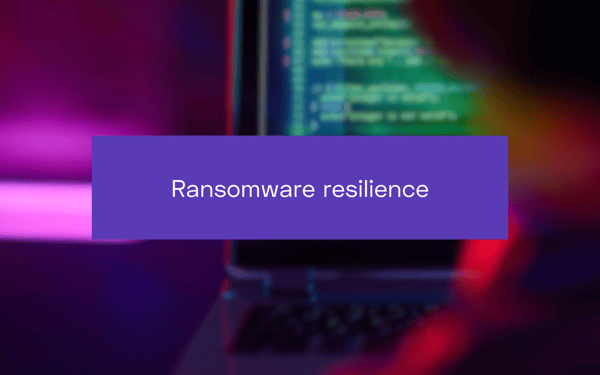This is part of an ongoing series of posts in which we’ll dive into the complexities and challenges facing modern SaaS platforms. We’ll also look at how we can leverage modern cloud architecture to keep our software safe, secure, and accessible.
In this blog post, Benny Olsson, CTO at Norce, will talk about how Norce implement “Secure by Design,” as part of its Secure Software Development Lifecycle, highlighting the benefits of a proactive stance on security and why it’s crucial in today’s digital landscape.
Proactive Cybersecurity: How Norce ensures robust security at every layer
In today's evolving digital landscape, cyber threats are becoming more sophisticated and relentless, making it imperative for businesses to adopt a proactive stance on security. At Norce, we understand that security isn’t something you implement once and forget. It needs to be deeply ingrained in every aspect of our operations, from software development to the hosting environments we manage for our multi-tenant SaaS platform for digital commerce.
In this post, we’ll walk through how Norce approaches cybersecurity with a proactive mindset across our hosting infrastructure and software development lifecycle. By integrating security early and continuously, we ensure our customers’ data and systems remain protected, while strengthening resilience against emerging threats.
Hosting security: Adopting a zero-trust mindset
Our hosting infrastructure is built with security as a top priority. We leverage Microsoft Azure’s robust cloud services while adopting a "Zero Trust" approach to ensure that every component of our environment – from network to compute and databases – is isolated and secure.
A zero-trust approach means we don’t take anything for granted. Every connection, action, and user is verified continuously to ensure there are no weaknesses that can be exploited. We collaborate closely with Microsoft’s specialized security teams to design, implement, and verify our infrastructure, ensuring we follow best practices at every step.
By managing all infrastructure as code (IaC), we not only ensure transparency and traceability for all changes but also allow ourselves to quickly recover in the case of a disaster. The automated nature of IaC allows us to scan configurations continuously to identify vulnerabilities before they become critical issues. This proactive stance strengthens our ability to detect and mitigate risks early, which is essential in today's fast-moving cyber threat landscape.
Secure Software Development Lifecycle (S-SDLC): Embedding security from the start
At Norce, we embed security into every stage of the software development lifecycle (S-SDLC), adopting a shift-left approach. Security is addressed early in the design phase through threat modeling and analysis. By involving the development team right from the beginning, we avoid potential surprises down the line and are better equipped to understand and mitigate risks early on.
A key part of our S-SDLC is our rigorous risk assessment process. Every pull request (PR) to the main branch undergoes a security and stability risk assessment. This ensures that both the development team and product experts can focus their testing on the most critical areas before any code reaches production.
Once code is ready for deployment, we perform static code analysis and third-party library scanning, visualizing any known vulnerabilities within our system. Additionally, we run in-house penetration tests on all public APIs using tools like Burp Suite, guided by the OWASP Top 10 list of threats. This multi-layered approach to security testing helps us stay ahead of potential vulnerabilities and ensure our platform is as secure as possible.
Bridging the gap between hosting and development: Unified security monitoring
Security doesn’t stop once the code is deployed. We continue to monitor our systems using a self-hosted instance of Grafana. This provides real-time, seamless monitoring across our entire infrastructure, network, and applications. In the event of an incident, we can quickly correlate events across the platform, making incident management more efficient and targeted.
Our development and hosting teams collaborate closely to plan for disaster recovery. Together, they create playbooks for various disaster scenarios, ensuring that if the worst happens – whether a security breach or an infrastructure issue – we are prepared to respond quickly and effectively. Every incident is followed by a formal Post Incident Review, managed by an Incident Manager. This thorough review process produces detailed reports that are shared with affected customers, and the lessons learned often lead to improvements in infrastructure, software, or processes.
Why a proactive stance on cybersecurity matters
In a world where cyber threats are increasing in both frequency and complexity, adopting a proactive approach to cybersecurity is essential. By integrating security into every phase of software development and maintaining rigorous hosting environment protocols, we at Norce strive to stay one step ahead of potential vulnerabilities.
This proactive approach not only enhances the security of our platform but also builds trust with our customers. In today’s cyber threat landscape, a reactive approach is no longer sufficient. The key is to anticipate risks and build systems that are inherently secure by design, reducing the likelihood of breaches and ensuring a swift response if incidents do occur.
How is your business taking a proactive stance on security? What challenges have you faced, and how are you overcoming them? We believe cybersecurity is a shared responsibility and that we can collectively build a safer digital future. Share this blog post if you found it valuable, and let’s keep the conversation going!



